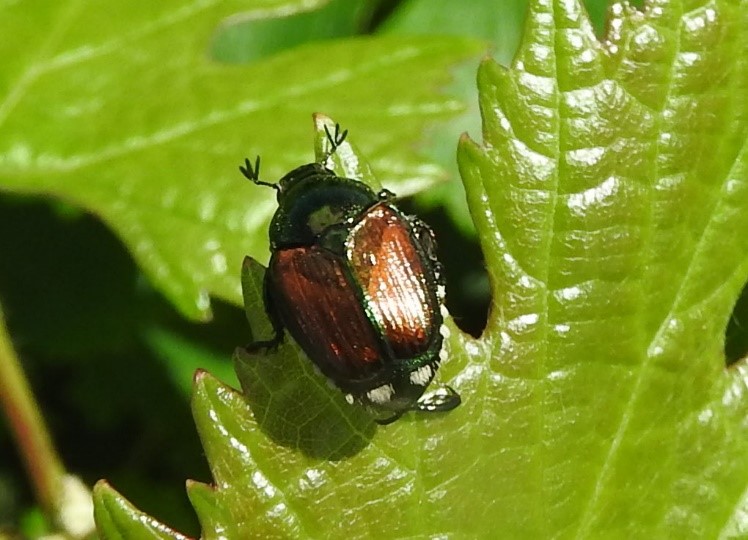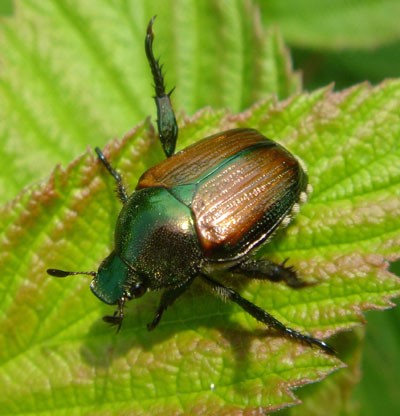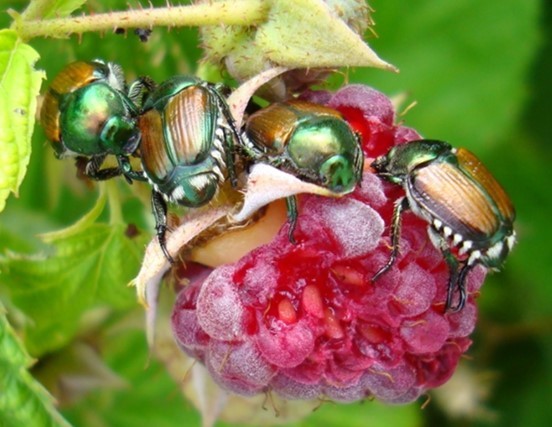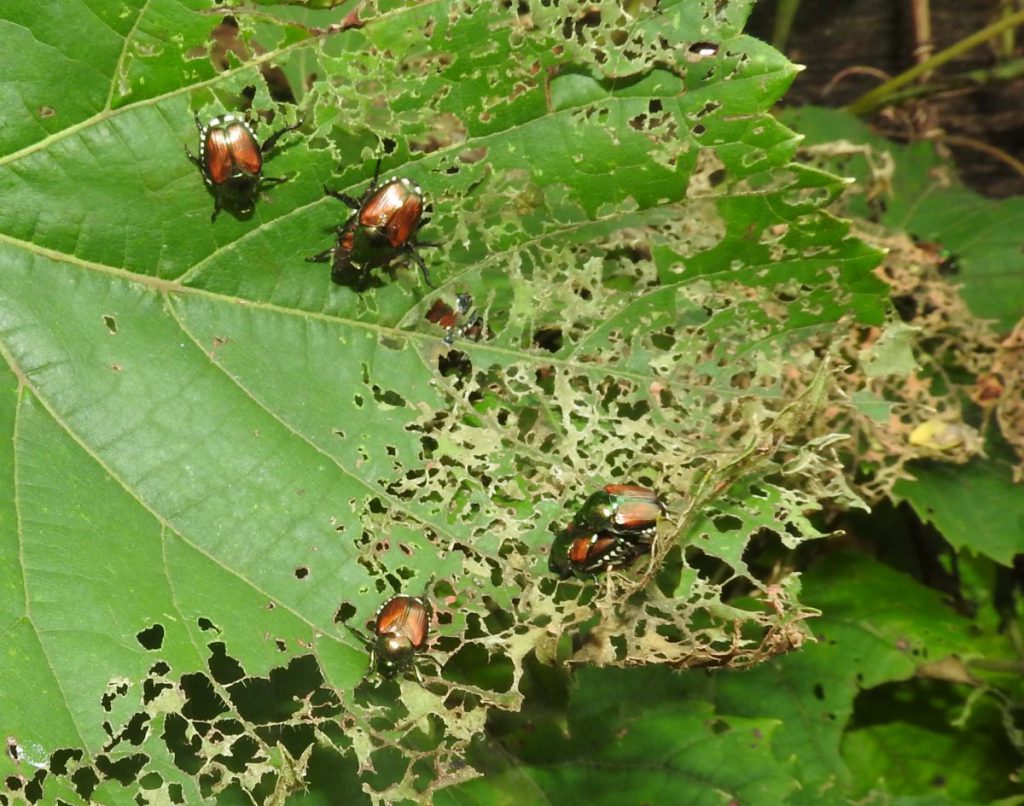Douglas G. Pfeiffer, Dept. Entomology, Virginia Tech, Blacksburg VA 24060, dgpfeiff@vt.edu
We are now into the Japanese beetle (JB) season – This is an annual threat for us, though the severity varies quite a bit from year to year. Some invasive pests have been with us that we no longer think of them as invasive, but JB truly is. JB was introduced into New Jersey about 1913, and has been spreading since. It is now spread through most of the eastern states, though absent in much of the Deep South. JB is absent through most of the West, being limited by dry soils. There have been individual introductions, generally followed by eradication efforts. Of particular concern is California, since so much of our food comes from that state, and JB has a very broad host range.
JB is noted by its coppery-colored elytra (the front wings of a beetle), green pronotum, with tufts of white hairs along the edge of the abdomen. Like all scarab beetles, JB has a lop-sided club on the end of the antennae. There are three segments on that club, and the inner surfaces are lined with sensory hairs that detect air movement and host odors. Just before taking off, theses segments are spread, in effect their flight control system!


In my IPM class, I talk about direct injury versus indirect injury – to the harvested part of the plant versus any other part. I ask the class whether JB is a direct pest or an indirect pest. It’s a trick question, because it’s both. They type of feeding depends on the crop. On caneberries and peach, it causes direct injury, making a real mess of berries and peaches. On grape and apple, it causes indirect injury, with most feeding on leaves (unless fruit is already injured, especially if overripe). This of course will affect the number of feeding insects that can be tolerated.
JB in crop settings are highly affected by the surrounding habitat. The larvae feed on grass roots, a habit that makes this species, as well as other white grubs, the most important pest of turf crops. JB will breed in lawns, pasture and other grassy areas. Consequently, if a fruit planting is surrounded by pasture, JB pressure will be higher. There are also climatic factors that cause variation severity from year to year. Scarab eggs are poor at retaining water. If soils are too dry, there is greater natural mortality of JB eggs (this is one reason JB has a hard time establishing in arid areas). In drought years, there is less successful establishment of eggs and young larvae in the soil; consequently, there will be fewer adults the following season. A rule of thumb is 10 inches of rain over June, July and August.
Let’s look at two crops where the beetles cause direct versus indirect injury – fruit versus leaf injury.
Caneberries
Caneberries are very vulnerable to JB feeding. Berries consume ripe berries eagerly sometime in high numbers. While JB can be an issue on both floricane and primocane-bearing varieties, the fruiting period of primocane-bearing varieties pushes more into the JB adult feeding period. Control of JB on caneberries is complicated by the extended blooming/ripening/harvest events. Ripening berries that are attractive to JB and must be protected occur concurrently with open blossoms, where bee safety is a concern. An additional concern is Pre-Harvest Interval (PHI) of effective materials. Ideally, it would be great to be able to spray the day before or the day of harvest; this is often not possible. Growers may have to settle for 3-day PHI, which may work into their schedule for practical reasons.
There are several materials that can be used here. Among conventional synthetic materials, Sevin XLR Plus has rapid action against JB, but its 7-day PHI may interfere with harvest schedules. The neonicotinoids Actara and Admire Pro each have 3-day PHI in foliar applications. Assail has a 1-day PHI. There are some OMRI-approved alternatives as well. Some of these are neem-based, with azadirachtin as the main active ingredient. Aza-Direct, Neemix and Trilogy all have a 0-day PHI (Neemix and Trilogy should be applied as a blend. Azadirachtin has a complex mode of action. It is partly an insect growth regulator, when it blocks the production of the molting hormone ecdysone. Obviously, this will affect larvae and not adults, so does not really relate here, where we have adults attacking the fruit. It also works as an anti-feedant/repellant. It is important to remember that once JB are established and feeding, the plants are more attractive. If one waits until the beetles are well established, the attractiveness of the beetle-infested plants will work against the repellant quality of the azadirachtin. Surround (kaolin) is another OMRI-approved option, but has some label restrictions that limit its utility: “Apply on fresh market berries only up to the first three weeks after fruit set as trace residues can be difficulty to remove after harvest. Application of plain water via normal sprayer prior to harvest can help to reduce Surround WP residues.” A newer organic alternative is beetleGone, a preparation of Bacillus thuringiensis. This is the subspecies galleriae, toxic to Coleoptera. Many growers are more familiar the type of Bt that is effective on caterpillars – subspecies kurstaki.

Grapes
By contrast, JB is primarily a leaf feeder on grapevines. Young vines can be completely defoliated and must be protected stringently. With mature vines, the situation is more nuanced. JB causes a skeletonizing type of foliar injury, leaving veins in place after removing leaf tissue. The JB adults do most of their feeing in the upper canopy of their various hosts, whether grapevines or apple trees. One factor that allows the vines to tolerate some feeding is that light that passes through the skeletonized leaves will impinge on leaves below, that would otherwise have been shaded. That only goes so far though, because the impact comes not just from loss of photosynthetic area, but is also a water loss problem, from edges of feeding wounds.
Some feeding occurs before véraison, and some after. Our earlier work on JB feeding on grapevines showed that feeding after véraison has a greater impact that that before the beginning of ripening occurs. This is because this is the time berries become the sinks for photosynthates. When beetles were caged on grapevines, feeding pre véraison had little impact. After véraison, an average of 10-11% leaf area loss averaged of the whole vine resulted in lowered fruit sugars.
There is a selection of materials to use here as well. Among the conventional synthetic materials, we have Sevin XLR, a carbamate, Imidan (an organophosphate, probably impractical because of the 14-day Restricted Entry Interval), the neonicotinoids Belay, Actara and Assail, and Avaunt. For organic control, Neemix plus Trilogy can be a useful mix, beetleGone, and here Surround has greater utility than in caneberries.
Our summer rains can be quite variable, but it’s worth paying attention to get an idea of the potential JB pressure in the coming season.
